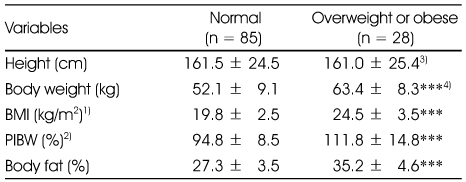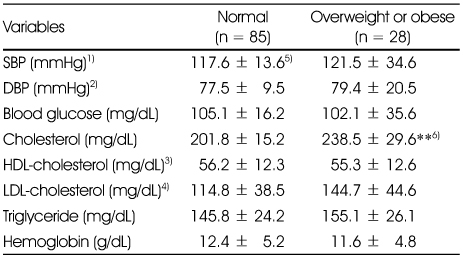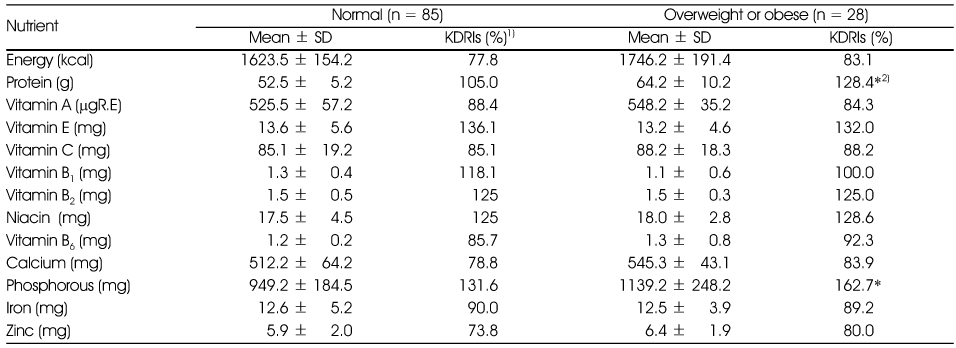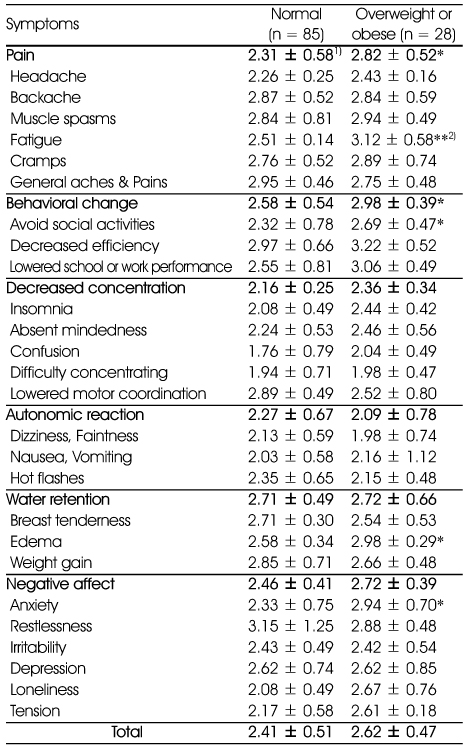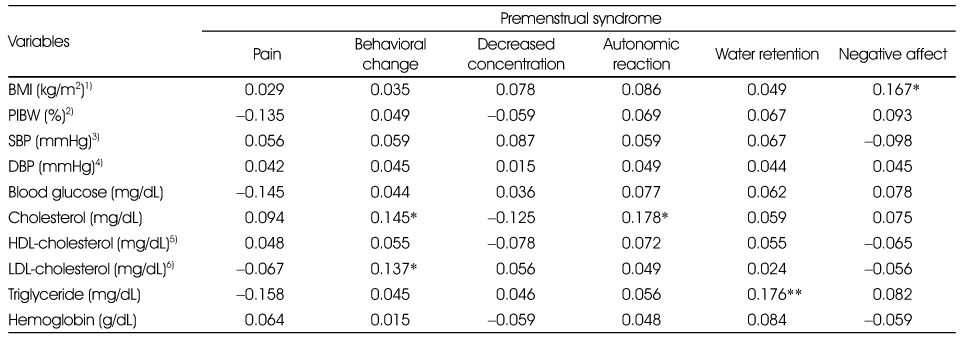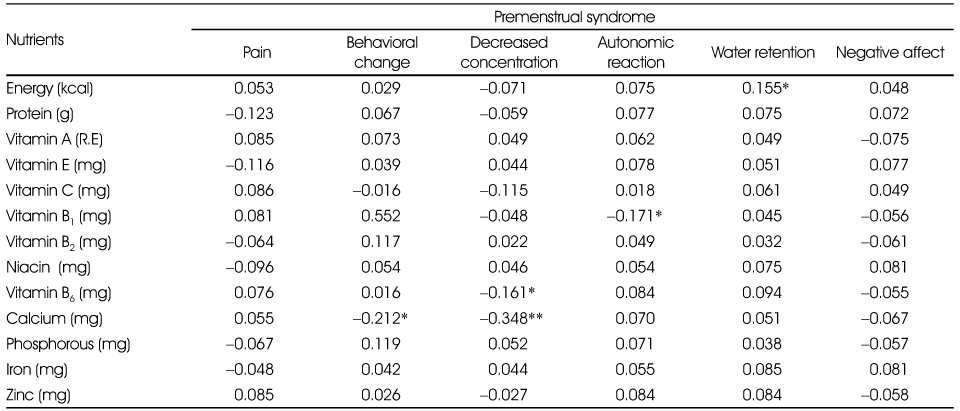References
1. Bae HS. Dietary intake, serum lipids, iron index and antioxidant status by percent body fat of young females. Korean J Community Nutr 2008. 13(3)323–333.
2. Beck AT, Epstein N, Brown G, Steer RA. An inventory for measuring clinical anxiety: psychometric properties. J Consult Clin Psychol 1988. 56(6)893–897.
3. Bendich . The potential for dietary supplement to reduce premenstrual syndrme (PMS). J Am Coll Nutr 2000. 19(1)3–12.
4. Chuong CJ, Dawson EB, Smith ER. Vitamin E levels in premenstrual syndrome. Am J Obstet Gynecol 1990. 163(5)1591–1595.
5. Coelho R, Silva C, Maia A, Prata J. Bone mineral density and depression: a community study in women. J Psychosom Res 1999. 4629–35.
6. Cohen S, Kamarck T, Mermelstein R. A global measure of perceived stress. J Health Soc Behav 1983. 24(4)385–396.
7. De souza MC, Walker AF, Robinson PA, Bolland K. A synergistic effect of a daily supplement for 1 month of 200 mg magnesium plus 50 mg vitamin B6 for the relief of anxiety-related premenstrual symptoms: a randomized, double-blind, cross-over study. J Womens Health Gend Based Med 2000. 9(2)131–139.
8. Facchinetti F, Borella P, Sances Fioroni L, Nappi RE, Genazzani AR. Oral magnesium successfully relieves premenstrual mood changes. Obstet Gynecol 1991. 78(2)177–181.
9. Greene R, Dalton K. The premenstrual syndrome. BMJ 1953. 1(4818)1007–1014.
10. Halbrich U, Endicott J, Schacht S, Nee J. The diversity of premenstrual changes as reflected in the premenstrual assessment form. Acta Psychiatr Scand 1982. 65(1)46–65.
11. Herrera H, Rebato E, Arechabaleta G, Lagrange H, Salces I, Susanne C. Body mass index and energy intake in Venezuelan university students. Nutr Res 2003. 23(3)389–400.
12. Hwang HJ, Kim YM. A study of premenstrual syndrome (PMS) and the nutritional intake of college woman residing in Busan metropolitan city. Korean J Community Nutr 2002. 7(6)731–740.
13. Johnson SR. The epidemiology and social impact of premenstrual symptoms. Clin Obstet Gynecol 1987. 30(2)367–376.
14. Kim OH, Kim JH. Food intake and clinical blood indices of female college students by body mass index. Korean J Community Nutr 2006. 11(3)307–316.
15. Kim SH, Lee JH. A study on relation between premenstrual syndrome (PMS) and nutritional intake, blood composition of female college students. Korean J Community Nutr 2005. 10(5)603–614.
16. Kim HO, Lim SW, Woo HY, Kim KH. Premenstrual syndrome and dysmenorrhea in Korean adolescent girls. Korean J Obstet Gynecol 2008. 51(11)1322–1329.
17. Korean Nutrition Society. Dietary reference intake for Korean 2010.
18. Lauersen NH. Recognition and treatment of premenstrual syndrome. Nurse Pract 1985. 10(3)11–12.
1518–20 passim.
19. London RS, Murphy L, Kitlowski KE, Reynolds MA. Efficacy of α-tocopherol in the treatment of premenstrual syndrome. J Reprod Med 1987. 32(6)400–402.
20. Michelson D, Stratakis C, Hill L, Reynolds J, Galliven E, Chrousos G, Gold P. Bone mineral density in women with depression. N Engl J Med 1996. 335(16)1176–1181.
21. Mortola J. Premenstrual syndrome-pathophysiologic considerations. N Engl J Med 1998. 338(4)256–257.
22. Moos RH. The development of a menstrual distress questionnaire. Psychosom Med 1968. 30(6)853–867.
23. O'Brien PM. Helping women with premenstrual syndrome. BMJ 1993. 307(6917)1471–1475.
24. Park KH, Sung NJ, Bae JI, Lee DU. The effects of body mass index change and lifestyles on change of serum total cholesterol levels. Dongguk J Med 2003. 10(2)200–207.
25. Park KS, Lee KA. A case study on the effect of Ca intake on depression and anxiety. Korean J Nutr 2002. 35(1)45–52.
26. Pitts CA. Premenstrual syndrome: Current assessment and management. Nursing Forum 1987. 23(4)127–133.
27. Romieu L, Willett MJ, Stampfer MJ, Colditz GA, Sampson L, Rosner B, Hennekens CH, Speizer FE. Energy intake and other determinants of relative weight. Am J Clin Nutr 1988. 47(3)406–412.
28. Steinberg S, Annable L, Young SN, Liyanage N. Placebo-controlled clinical trial of L-tryptophan in premenstrual dysphoria. Biol Psychiatry 1999. 45(3)313–320.
29. Singh B, Berman B, Simpson R, Annechild A. Incidence of premenstrual syndrome and remedy usage: a national probability sample study. Altern Ther Health Med 1998. 4(3)75–79.
30. Taylor RJ, Fordyce ID, Aleander DA. Relationship between personality and premenstrual symptoms. Br J Gen Pract 1991. 41(343)55–57.
31. Thys-Jacobs S, Alvir MJ. Calcium-regulating hormones across the menstrual cycle: evidence of a secondary hyperparathyroidism in women with PMS. J Clin Endocrinol Metab 1995. 80(7)2227–2232.
32. Thys-Jacobs S. Micronutrients and the premenstrual syndrome. J Am Coll Nutr 2000. 19(2)220–227.
33. Thys-Jacobs S, Starkey P, Bernstein D. Calcium carbonate and the premenstrual syndrome: effects on premenstrual and menstrual symptoms. Am J Obstet Gynecol 1998. 179(2)444–452.
34. Wyatt KM, Dimmock PW, Jones PW, O'Brian PMS. Efficacy of vitamin B-6 in the treatment of premenstrual syndrome: systematic review. BMJ 1999. 318(7195)1375–1381.
35. Yook SP, Kim JS. A clinical study on the Korean version of beck anxiety inventory: comparative study of patient and non-patient. Korean J Clin Psychol 1997. 16(1)185–197.
36. Yu HH, Nam JE, Kim IS. A study of nutritional intake and health condition of female college students as related to their frequency of eating breakfast. Korean J Community Nutr 2003. 8(6)964–976.
